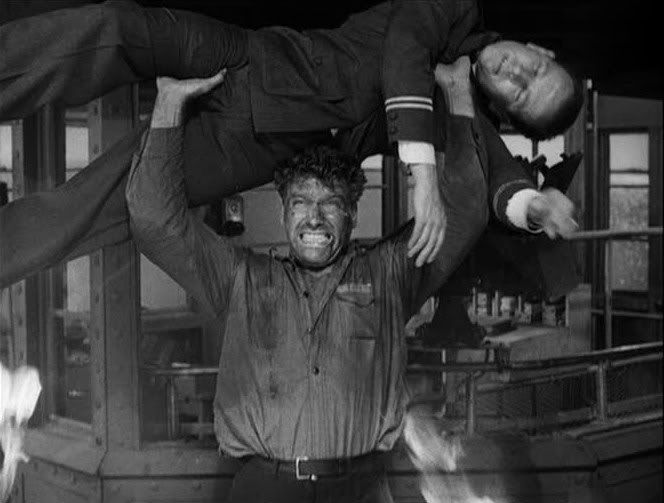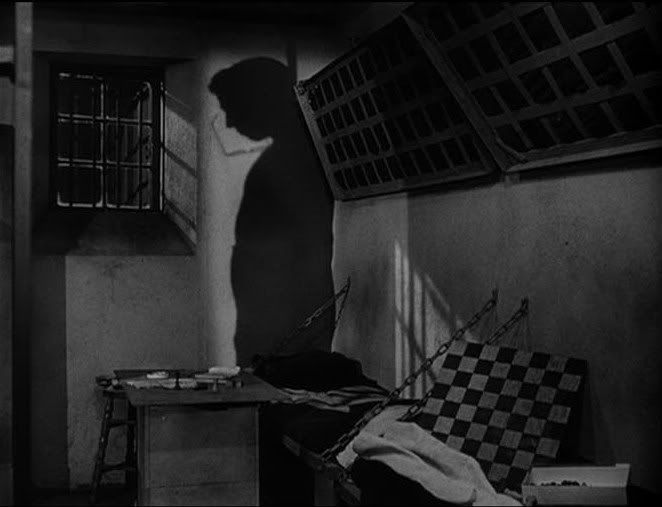
Jules Dassin's Brute Force is a dark, fatalistic prison noir, a film in which there is no exit, no freedom, no opportunity for escape — it's an unrelentingly oppressive journey towards its final confirmation that bloody destiny is inescapable. The film is set in a prison that's dominated by the cruel, sadistic guard captain Munsey (Hume Cronyn), who keeps the men under his charge on a tight leash through brutality and manipulation. Not only that, but he seems to take pleasure in it; when he's beating an inmate, or driving another to suicide by spreading lies about the man's beloved wife, a small smile inevitably creeps across his lips, while his eyes bulge in insane joy. The film presents the prison as a near-complete moral vacuum, a place where if anything the prisoners are mostly morally superior to those who watch over them. The prisoners are men who have made mistakes, who have done stupid things, committed petty crimes for foolish reasons, or been betrayed or framed. On the other hand, if Munsey is a brutish sadist, the prison's warden (Roman Bohnen) is a coward with no ability to curb his underlings' excesses, while the good-hearted doctor (Art Smith) tries his best to resist such brutality, but mostly just drowns himself in booze. He's prone to boozy speechifying, to bursts of righteous outrage and indignation, but all his fiery oration never has any impact despite his good intentions. Even so, he does provide the apt summation of Munsey's approach that provides the film with its title: "not imagination, not cleverness, just force... brute force."
Dassin surrounds the prisoners with an oppressive system that offers no possibility for escape. As Munsey makes clear, he's the one who decides what prisoners have been on "good behavior," and therefore he more or less controls the parole system. This means that the prisoners understand parole as an empty promise, and collaborating with Munsey is equally fruitless since it practically guarantees death by fellow prisoners: one "stool pigeon" meets his end in a license plate press, chased there by inmates with blowtorches. Dassin is essentially showing how few options are open to these men, closing each avenue of escape off one by one, demonstrating that there's really no hope. The stool pigeon tries to gain his freedom by turning on his fellow inmates, and meets a grisly end as a result, while Munsey brushes the man off once he's done with him, not caring about his fate. The prison newspaper editor Gallagher (Charles Bickford) hopes to gain his freedom through parole, by maintaining friendships with both guards and inmates, helping to keep the whole prison system running smoothly. But he soon enough learns that parole is a remote hope, especially when the prison board arbitrarily decides to suspend all parole hearings, demonstrating conclusively just how little control these men have over their circumstances. Lister (Whit Bissell) tries to keep to himself, only concerning himself with writing letters to his wife, but Munsey's intervention teaches him that even this is not a tenable position.
The film's mood is one of claustrophobic intensity. Dassin films the men in their cramped cells, packed together within these concrete walls, the bars casting striped shadows on their faces, as they squirm and plot under the restrictions enforced by Munsey. The men all want something on the outside. Collins (Burt Lancaster) wants to be reunited with his sickly girlfriend Ruth (Ann Blyth), who is wasting away in his absence. Soldier (Howard Duff) wants to get back to his Italian wife, for whom he took the fall in the first place, risking his career to get her and her father rare post-war food and supplies. The others have girls and dreams, too. Dassin awkwardly shoehorns in the men's flashbacks to their pre-jail days, and these saccharine diversions seem to have come from a different movie, with melodramatic acting and trite stories. These interludes don't serve the film particularly well, since they distract from what is otherwise an all-encompassing claustrophobia and dread, the sense of being trapped within the walls of the prison. The flashbacks, by taking the action outside the jail walls, dilute the film's feeling of being trapped along with these men, and moreover these scenes are unnecessary to establishing the stakes of escape. The desire to get out is written in every man's face anyway, in their desperate eyes, and the flashbacks don't do anything that a couple of terse lines of dialogue don't do just as well.

Flashbacks aside, the film is a stark, angry prison drama, and Dassin does a good job of ratcheting up the men's desperation until an escape attempt seems like the only possible solution. Early on, a glimpse of freedom is offered by the sight of the prison's gates opening and its drawbridge going down to let out a car carrying the body of a dead prisoner. Dassin films this shot as though it were the gates of Heaven itself opening: there's something ecstatic about the sight of an open road appearing where before there had only been forbidding walls. Collins watches with yearning, not realizing that this scene confirms what they all already know, that dying is one of the few ways to ensure that those gates will open and the bridge will lower.
This tension pays off in the final sequences, as Munsey's sadism reaches previously unimagined levels. The captain's beating of an inmate who he suspects of being involved with the escape plan is truly brutal, and Dassin films the scene mostly through suggestion, with the actual violence happening off-screen. Instead, Dassin captures the expression of mad pleasure, nearly lustful, that plays across the captain's face as he beats this man. Cronyn, so bland and innocent-looking, plays the role with obvious relish, brilliantly portraying the banality of evil, the ordinary sadist whose own ambitions and dreams are modest, and seemingly extend no further than the advancement of his career. In service to these utterly conventional middle-class ambitions, he commits acts of unspeakable horror and nastiness, not because they're strictly necessary but because he enjoys it, and because he's convinced himself that brutality is the only possible response to his charges.
The escape attempt itself is predictably violent and nasty, as the prison is set ablaze, so that the whole sequence seems to be playing out in this fortified Hell, flames licking up at the men's desperate, rage-filled faces, as they struggle against impossible odds to get those gates open again, to get their revenge. By this time, the film's mood has reached a fever-pitch peak of insanity and cruelty, as the prisoners and the guards prove themselves equally capable of pointless violence and destruction, while everyone's confused plans fall apart all around them. In the end, no one gets what they want, and no one can escape. It's the fatalistic essence of the noir, a lesson Dassin imparts in a point-blank coda that underlines the impossibility of escape, the fact that bars — literal and metaphorical — cage us all.







0Awesome Comments!